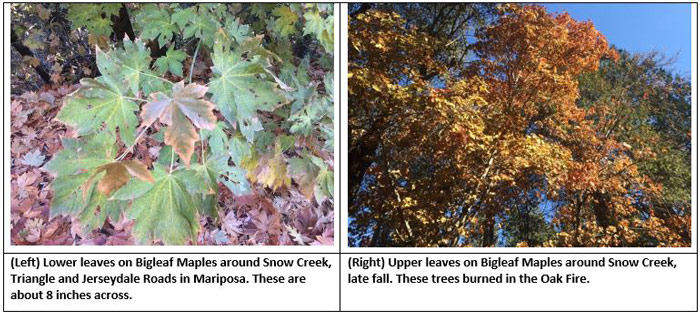 May 23, 2023 - Ron Allen, UC Master Gardener, Mariposa County - With the Oak Fire of July 2022 in focus, a previous article in March, explained how to plant conifer seedlings for forest restoration. In fact, a combination of tree species is important for ecologically healthy woodland. This article describes how to select, plant, and nurture broadleaf trees after a wildfire.
May 23, 2023 - Ron Allen, UC Master Gardener, Mariposa County - With the Oak Fire of July 2022 in focus, a previous article in March, explained how to plant conifer seedlings for forest restoration. In fact, a combination of tree species is important for ecologically healthy woodland. This article describes how to select, plant, and nurture broadleaf trees after a wildfire.
It might seem perverse to talk about planting oak trees after the Oak Fire, but that is exactly what I suggest. In California, oak woodlands support a more biodiverse environment than any other major ecosystem. Moreover, oak-dominant landscapes are critical to preventing soil erosion and landslides. Oak woodlands regulate water flow in watersheds and maintain stream and river water quality.
Interestingly, oaks are actually resistant to and even tend to suppress fires. They suppress fires through the cover of leaf litter beneath their drip zone. While the upper layer of dead leaves might burn, the moisture maintained deeper in the litter prevents high, climbing fires. With their thick barks and retained moisture in their leaves, stems, and branches, California oaks attenuate ladder fires and have adapted to survive wildfires.
There are six oak trees native to Mariposa County. The Blue Oak and the Interior Live Oak are foothill species. Appropriate to the mountains east of town are the Black Oak, Valley Oak, Canyon Live Oak, and the Oregon White (Garry’s) Oak.
The Valley Oak is arguably the largest oak in North America, and it grows fast—for an oak tree—about two feet per year. But, it needs to be planted near a water source to thrive. The other oaks are suitable for slopes, but they only grow about twelve inches per year.
For quicker shade, the Fremont Cottonwood and the Black Cottonwood are possibilities. They grow 10-15 feet per year and about 5 feet per year, respectively. The Black Cottonwood is a better choice above 3,000 feet elevation. These need to be planted near a water source. One problem with both these trees is that they—the typical euphemism is “self-prune”—are subject to branch breakage. Don’t site one next to your patio!
A great choice for establishing shade is the Bigleaf Maple, native to the Pacific Coast and the western Sierra Nevada. Near water it can grow 3 to 6 feet per year. With leaves 8-12 inches wide on young trees, and up to two feet in diameter on mature specimens, this is truly the champion among our broadleaf trees.
Another excellent broadleaf shade tree for reforestation is the California Sycamore. It grows quickly (2-4 feet per year), has attractive mottled bark, large leaves, and is disease resistant. Plant it near a water source or provide supplemental water during warm months for best growth.
No matter how enthusiastic you are about restoring shade to spaces near your structures, please remember that CalFire requests that landscape trees be at least thirty feet away from buildings.
Planting broadleaf trees follows the same steps as for conifers. Dig a hole twice as big as the volume of the container. Set the new tree so that the container soil is level with the ground or about a half-inch above.
Refill the hole with the original soil. Avoid soil amendments, unless the planting area was subject to a very hot fire, as evidenced by white ash on site. In this case, mix in potting soil with an inoculation of mycorrhizal fungi. Water the plant well to eliminate air spaces in the ground. Cover the area with coarse mulch, but do not thereby crowd the plant stem. Provide supplemental water for the first warm season: One gallon once per week is adequate.
Future articles will cover the post-fire restoration of small trees, shrubs, and meadow areas.
For assistance, contact our Helpline at (209) 966-7078 or at mgmariposa@ucdavis.edu. We are currently unable to take samples or meet with you in person but welcome pictures.
The U.C. Master Gardener Helpline is staffed; Tuesdays from 9:00 A.M. - 12:00 P.M. and Thursdays from 2:00 P.M. - 5:00 P.M.
Clients may bring samples to the Agricultural Extension Office located at the Mariposa Fairgrounds, but the Master Gardener office is not open to the public. We will not be doing home visits this year due to UCANR restrictions.
Helpline Serving Mariposa County, including Greeley Hill, Coulterville, and Don Pedro
Please contact the helpline, or leave a message by phone at: (209) 966-7078
By email (send photos and questions for researched answers) to: mgmariposa@ucdavis.edu
For further gardening information and event announcements, please visit: UCMG website: https://cemariposa.ucanr.edu/Master_Gardener
Follow us on Facebook at: https://www.facebook.com/mariposamastergardeners
Master Gardener Office Location:
UC Cooperative Extension Office,
5009 Fairgrounds Road
Mariposa, CA 95338
Phone: (209) 966-2417
Email: mgmariposa@ucdavis.edu
Website: http://cemariposa.ucanr.edu/Master_Gardener
Visit the YouTube channel at UCCE Mariposa.
Listen to us on the radio at KRYZ 98.5 Mariposa on Wednesdays at 2:00 P.M. and Saturdays at 5:00 P.M.









